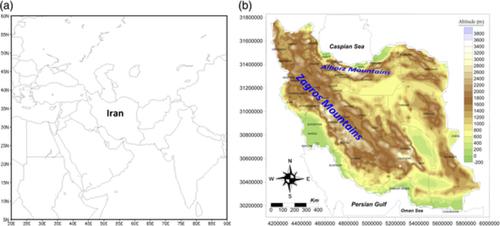当前位置:
X-MOL 学术
›
Meteorol. Appl.
›
论文详情
Our official English website, www.x-mol.net, welcomes your
feedback! (Note: you will need to create a separate account there.)
Temporal and spatial analysis of thermal stress and its trend in Iran
Meteorological Applications ( IF 2.3 ) Pub Date : 2021-02-17 , DOI: 10.1002/met.1977 Bakhtiyar Mohammadi 1 , Samireh Barnameh 2 , Andreas Matzarakis 3
Meteorological Applications ( IF 2.3 ) Pub Date : 2021-02-17 , DOI: 10.1002/met.1977 Bakhtiyar Mohammadi 1 , Samireh Barnameh 2 , Andreas Matzarakis 3
Affiliation

|
The study was conducted to determine thermal stress and its trend in Iran. The atmospheric variables of 304 synoptic stations, including mean temperature, relative humidity, wind speed and cloudiness, for the period 1961–2010, were used to identify the thermal stress conditions in Iran. These data were prepared on a daily basis from the Iran Meteorological Organization. Physiologically equivalent temperature (PET) and standard effective temperature (SET*) were used to identify thermal stress. Also, thermal stress was studied with a simple linear regression method and at a 95% confidence level. The results of the study revealed that in Iran each location can experience different types of environmental conditions throughout the year. At a specified time, thermal stresses of different intensities can be seen. The other results showed that the mountainous regions, especially the highlands of the northwest, along with the Zagros and Alborz mountains, had the highest co‐efficient of variability (> 50%). Also, the southern regions of Iran have both monthly and annual scales with the least co‐efficient of variability (< 20%) in bioclimatic conditions. In general, a diversity of bioclimatic conditions is evident in Iran both temporally and spatially. The other part of the study determined that heat and cold stress and heat comfort had a positive trend (fewer than 60 stations) in parts of Iran, a negative trend in some other parts (more than 50 stations), and no specific trend in the remaining parts (more than 250 stations). Most of the northern stations, especially on the Caspian coast, have been shown to have a positive trend in the event of cold stress. Indeed, extreme bioclimatic conditions (very cold and hot conditions) have been rising in both the southern and northern latitudes of the country. Even in southern parts, a positive trend of cold and very cold conditions can be observed at some stations.
中文翻译:

伊朗热应力的时空分析及其趋势
进行该研究以确定伊朗的热应力及其趋势。利用1961-2010年期间304个天气观测站的大气变量,包括平均温度,相对湿度,风速和阴天,确定了伊朗的热应力条件。这些数据每天由伊朗气象组织提供。使用生理等效温度(PET)和标准有效温度(SET *)来识别热应力。此外,还采用简单的线性回归方法以95%的置信度研究了热应力。研究结果表明,在伊朗,每个地点全年都可能经历不同类型的环境条件。在指定的时间,可以看到不同强度的热应力。其他结果表明,山区,尤其是西北部的高地,以及Zagros和Alborz山区,变异系数最高(> 50%)。此外,伊朗南部地区在生物气候条件下具有月度和年度尺度,变异系数最小(<20%)。总的来说,伊朗在时间和空间上都存在多种多样的生物气候条件。该研究的另一部分确定,伊朗部分地区的热,冷应力和热舒适度呈正趋势(少于60个站点),其他一些部分呈负趋势(超过50个站点),而在伊朗的其他部分则无特定趋势。其余部分(超过250个工作站)。大部分北部车站,尤其是里海沿岸,事实证明,在寒冷压力下,这种趋势呈积极趋势。确实,该国南部和北部纬度的极端生物气候条件(非常寒冷和炎热的条件)都在上升。即使在南部地区,在某些站点也可以观察到寒冷和非常寒冷的状况呈积极趋势。
更新日期:2021-02-18
中文翻译:

伊朗热应力的时空分析及其趋势
进行该研究以确定伊朗的热应力及其趋势。利用1961-2010年期间304个天气观测站的大气变量,包括平均温度,相对湿度,风速和阴天,确定了伊朗的热应力条件。这些数据每天由伊朗气象组织提供。使用生理等效温度(PET)和标准有效温度(SET *)来识别热应力。此外,还采用简单的线性回归方法以95%的置信度研究了热应力。研究结果表明,在伊朗,每个地点全年都可能经历不同类型的环境条件。在指定的时间,可以看到不同强度的热应力。其他结果表明,山区,尤其是西北部的高地,以及Zagros和Alborz山区,变异系数最高(> 50%)。此外,伊朗南部地区在生物气候条件下具有月度和年度尺度,变异系数最小(<20%)。总的来说,伊朗在时间和空间上都存在多种多样的生物气候条件。该研究的另一部分确定,伊朗部分地区的热,冷应力和热舒适度呈正趋势(少于60个站点),其他一些部分呈负趋势(超过50个站点),而在伊朗的其他部分则无特定趋势。其余部分(超过250个工作站)。大部分北部车站,尤其是里海沿岸,事实证明,在寒冷压力下,这种趋势呈积极趋势。确实,该国南部和北部纬度的极端生物气候条件(非常寒冷和炎热的条件)都在上升。即使在南部地区,在某些站点也可以观察到寒冷和非常寒冷的状况呈积极趋势。











































 京公网安备 11010802027423号
京公网安备 11010802027423号